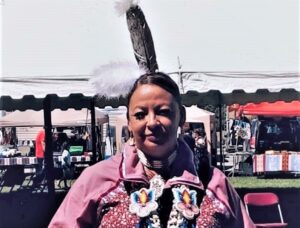Chippewas of the Thames First Nation harm reduction team find new ways to address substance-abuse problems amidst pandemic

By Colin Graf
DESHKAN ZIIBING (CHIPPEWAS OF THE THAMES FIRST NATION)— Efforts to fight a pandemic running parallel with the coronavirus disease 2019 (COVID-19) pandemic— a wide-spread increase in dangerous drug use— are ramping up in Chippewas of the Thames First Nation (COTTFN) as the local harm reduction team renews contact with those affected by substance-abuse problems.
With weekly outdoor gatherings, a Community Fire event, and preparations for drive-in style appointments, the Cultural Harm Reduction Outreach Team in COTTFN is providing services in new and unique ways this fall, says Coordinator Ann Marie Proulx-White.
When her team was allowed back in the office in Sept., Proulx-White started hearing from community members that they need more supports and, in order to follow pandemic protocols, she felt her workers needed to go mobile and reach out to the community without being “in a confined building.”
One of the team’s first efforts was holding weekly outdoor meetings on Thursdays at the local ball diamond to invite community members to “find out what we’re doing, what we have for support, what our services are,” Proulx-White says.
At their first meeting, only three people showed up; however, over a dozen came to the next meeting despite the wet weather. This offered her hope of reconnecting with people needing help who were isolated during the first COVID-19 wave in the spring. According to Proulx-White, her team is finding it easier to help people when they can meet them in-person, even if it is outdoors instead of their usual location at the Chippewa Health Centre.
Since the COVID-19 pandemic began, there have been numerous overdoses and some overdose-related deaths in the three adjacent communities the team serves— Chippewa of the Thames, Munsee Delaware Nation, and the Oneida…, she relates.
“We are in the middle of a drug pandemic. Many families are grieving now,” she says.
Prolonged isolation may well be driving the growth in drug problems, Proulx-White believes.
“Our people always need to feel connected. Even though they are already isolated in their addiction, now they are even more isolated from the world,” she says.
According to Proulx-White, the harm reduction team is hearing that some members of the three communities are driving the 20 kilometres to the nearby city of London for addiction services, so she is trying to build connections to agencies working with First Nations people there.
“A lot of the issues are around confidentiality, when you are dealing with that level of sensitivity around addiction,” she explains.
She adds that sensitivity and reluctance to be seen going for supplies such as needles and syringes is another reason for going mobile.
“We are trying to build that trust with our clientele; that relationship. They might not know who we are.”
The team’s work is not designed to help people kick a drug addiction, says Proulx-White.
“We’re here to help guide them and get them out from under the high-risk umbrella. We can’t cure people, but we can provide supports,” she says.
The outreach team also provides Mindigin, a traditional salve made from bear oil to help with skin sores that are often the result of using street drugs such as meth; the drug that is becoming a bigger and bigger problem in the area, according to Proulx-White.
“We’re trying to provide a sense of comfort. There’s no judgement; it’s all open, whether we know the client or not,” she says.
Guidance is also provided to help clients get access to other social and medical services if they want, and the harm reduction workers can connect clients with a traditional healer. The team also provides the traditional four medicines of cedar, tobacco, sweetgrass, and sage if requested.
As the weather gets colder, Proulx-White describes a plan to have workers meet clients at the two community centres in the area. The workers will be set up in a vehicle rather than in the centre if things go as she hopes.
A community fire was scheduled for Oct. 30, planned to honour the ancestors and to hold a Pipe Ceremony, she says.
“[The fire was hoped to] make a place where people can come for comfort, to have any sort of support they need,” Proulx-White says. “We just want people to have that space to pray and be with the fire and offer tobacco.”
Proulx-White says that the outreach team will also be focussing on virtual programming about harm reduction and traditional medicine during November, adding that the members are also trying to create a plan to help those who do not have internet access themselves to access the online sessions.
Cultural outreach workers Leroy Cornell, Gloria Boutcher and Proulx-White herself feel they have “absolutely” been able to help people in recent months.
“All of us have life lessons” to pass on, and see themselves as “Shkaabewis”— helpers for the people—she explains.


